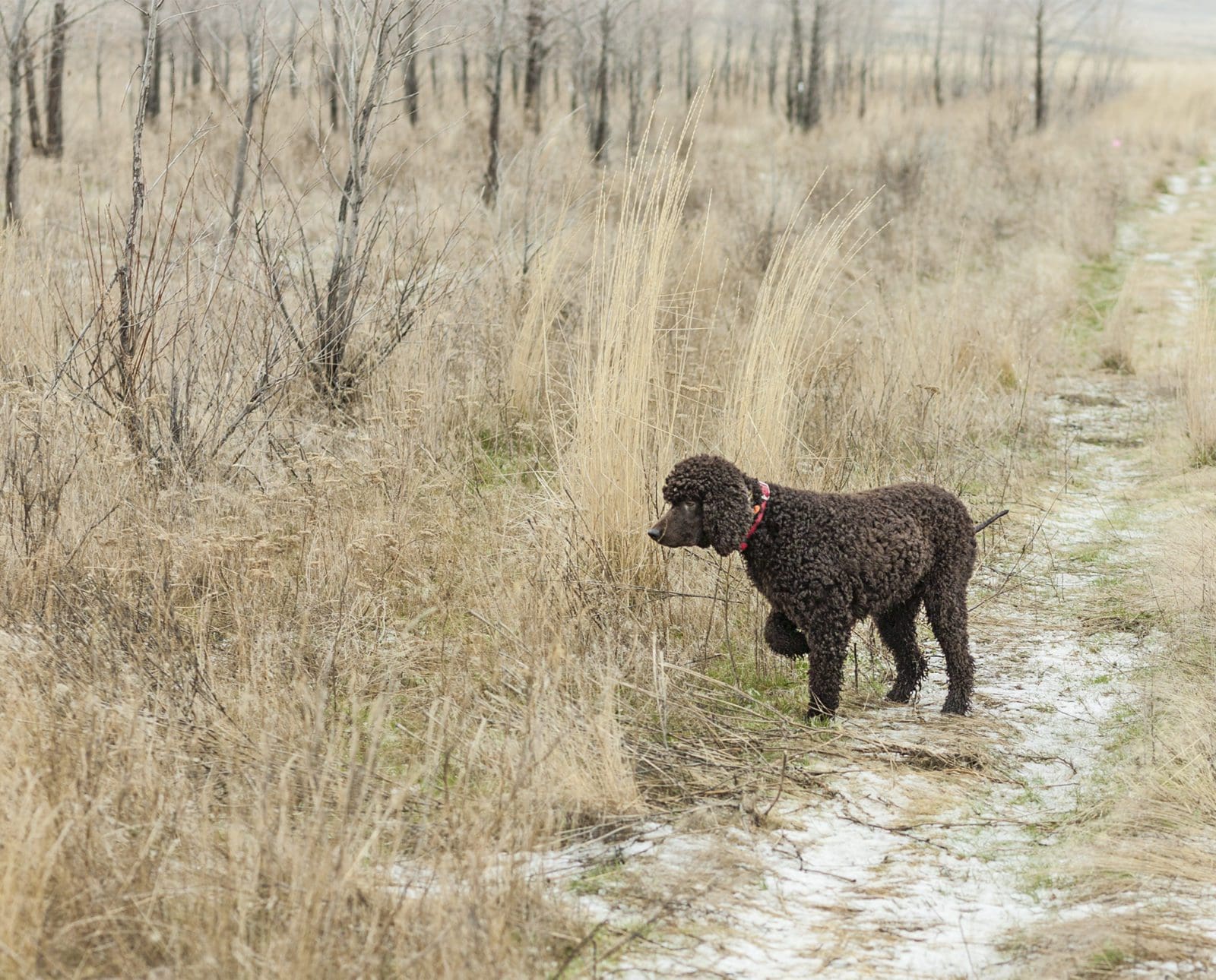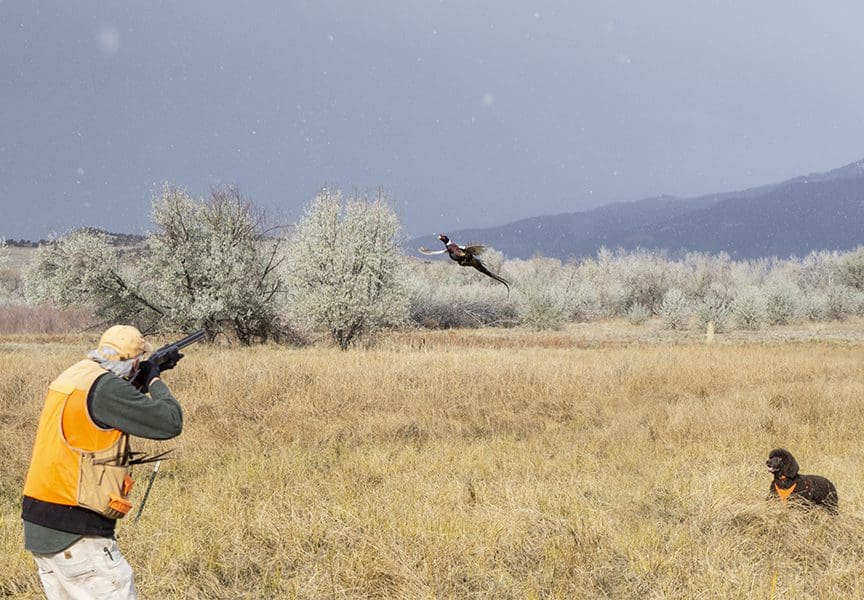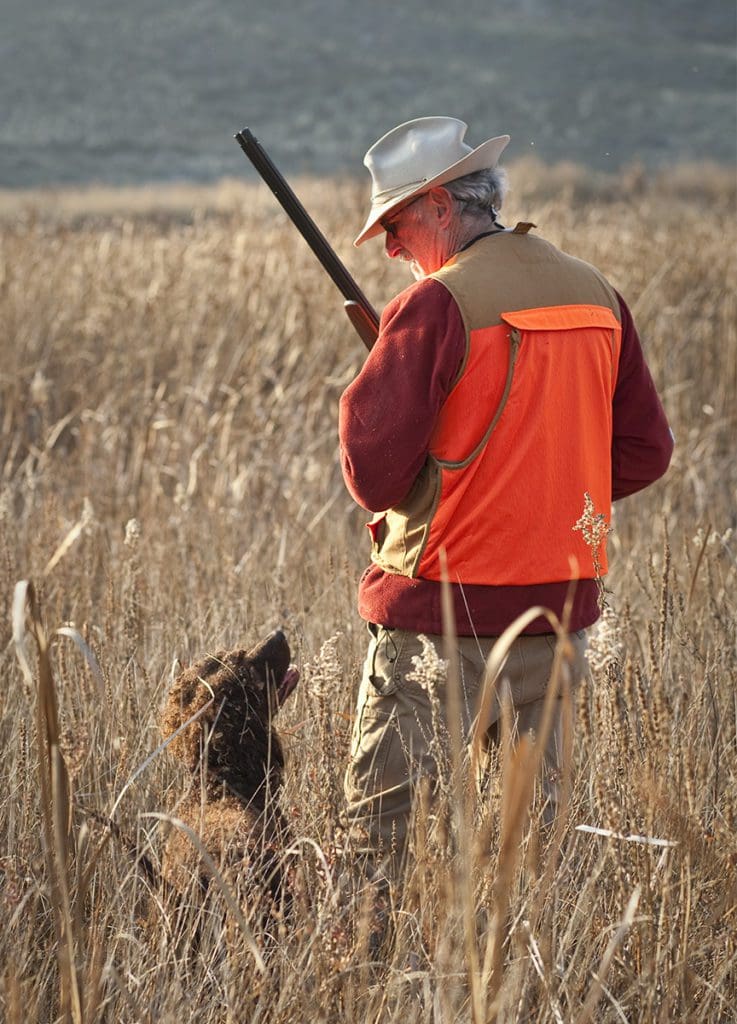Home » Hunting Dogs » The Importance of Training Steadiness in Bird Dogs
The Importance of Training Steadiness in Bird Dogs
- This article was originally published in Volume 3, Issue 3 of Project Upland Magazine.

Jennifer Wapenski is the Director of Operations and Managing Partner…
There are many reasons to train a dog to remain steady from flush to fall, whether for safety or personal enjoyment
When it comes to selecting a bird dog breed, there’s a common piece of advice handed out: “Choose a dog that hunts the way you hunt.” This is all well and good if you are a seasoned hunter—or if, in fact, you’ve ever hunted at all—but if you are coming into hunting completely green, it’s tough to imagine what your hunting style will be. And before you dive into the minutiae of the various breeds, you have to answer a fundamental question: flushing or pointing dog?
Listen to more articles on Apple | Google | Spotify | Audible
I arrived at this important decision with no practical experience, armed only with preconceived notions and some cursory internet research. Common wisdom said that pointing dogs gave plenty of advance warning before the bird appeared, giving the hunter time to compose herself, establish footing, shoulder the gun, and click off the safety. I imagined that hunting behind a buzzing little spaniel was nothing but chaos, with birds launching out of bushes like popcorn, dog hot on their tails, and taking the hunter completely by surprise. Feeling a little overwhelmed about the whole process already, a pointing dog seemed to be the less chaotic way to go.
The farther I dive into the hunting dog world, though, the more I realize that the finer points of a dog’s work have everything to do with the relationship, bilateral communication, and training that have been established between the dog and the handler. Pointing dogs are rarely steady without some training, and flushing dogs rarely bust birds out of cover without signaling what’s about to happen. The opportunity to read your dog and the obligation to work together to establish expected behaviors are universal, regardless of breed or type.
Co-hosting the Hunting Dog Confidential podcast has given me the opportunity to talk to hunters outside of my typical versatile hunting dog circles. Sure, there are some fundamental differences in the way that we run our various types of dogs, but when all is said and done, it seems like we have more in common than not.
One topic that has been of particular interest to me is the idea of steadiness. Those of us in the pointing dog world are familiar with the concept of training a dog to be steady to wing, shot, and fall. In other words, it must remain motionless as the bird takes wing, the shot is fired, and the dead bird drops back to the earth. While some dogs display a natural steadiness to some degree, it is absolutely a trained behavior that goes against their natural inclination to chase and catch the prey. Steadiness is a key component of more advanced hunt tests such as the NAVHDA Utility Test, the JGHV VGP Utility Test, and AKC senior- and master-level hunt tests. It is a hallmark of the “finished” dog.
I was surprised, however, to learn that steadiness is not unique to the pointing breeds. Craig Koshyk (my podcast co-host) and I discussed the concept as it applies to flushing spaniels in an interview with Russell Dodd, an AKC spaniel hunt test judge and Irish Water Spaniel enthusiast.
“We use ‘hup,’ a command which means, ‘Put your butt on the ground, and stay put,'” Dodd explained. “At the advanced levels of hunt tests or in hunting, you want that dog to be steady to flush, steady to the shot, and then not go retrieve that downed bird until released. It’s invaluable from a safety standpoint, especially if you are hunting with a brace of dogs.”
Just as with the pointing breeds, spaniels are expected to be steady through the flush, shot, and fall at the higher levels of hunt testing, such as the AKC master hunt test for spaniels.
Why should a hunter train for steadiness?
Even if you aren’t planning to test your hunting dog at the advanced levels, the question of steadiness is an important consideration in your training plan. The primary driving force behind a steady dog is ensuring their safety. This applies to both gun safety as well as situational safety.
You’ve seen the classic photo of a flushing dog snapping at the long tail feathers of a rooster as it flushes from its cover. It makes for a great photo but an unsafe shot in that moment. As long as that dog hups and stays put while the rooster flies off, the hunter will be granted an opportunity to take a safe shot at the bird as soon as it clears the cover. However, if the dog gives chase, the hunter must have one eye on the dog and another on the bird before safely pulling the trigger.
Dodd described having been in that situation and why a steady dog makes it safer and more enjoyable.
“The flushing spaniel, in their perfect world, would love to bust into the cover and grab the bird before it even leaves the ground,” he said. “If the bird takes off in a vertical flush, the dog is going to go airborne, pulling the bird out of the air. If you are a snap shot, the dog’s head might be awfully close to the bird. Plus, many upland birds tend to get up just four feet off the ground and fly right above the cover without really getting airborne. If the dog is on their tail, when you look down the barrel of your shotgun, you’re going to see the dog and then the bird. However, if the dog is steady, and the bird goes up, then you’ve got a safe line of sight. Even if you miss the first one, you can take a breath and get a second shot off, knowing that the dog is out of the picture.”

There are critical safety considerations beyond just firing a shot, too. A flushing bird—shot or unharmed—may sail across a road, across railroad tracks, or even off of a cliff. A dog that is fired up about the chase isn’t going to stop and apply common sense to the situation before proceeding.
Training a dog to be steady means that she can be sent for the retrieve in a controlled manner once the situation has been assessed and determined to be safe. For example, you may need to approach the road carefully to ensure that there is no traffic before crossing or ensure that railroad tracks are clear before sending the dog across. There is no need to put the dog’s life at risk for a retrieve or a secondary flush.
Safety aside, a steady dog can also create additional opportunities for a successful hunt. Dodd has seen plenty of these scenarios in his days afield.
“If the dog is steady to flush and shot, it makes marking easier and increases the probability of locating a downed bird,” he said. “Additionally, if there is a flyaway due to a shooter’s miss, the rest of the covey could be holding, and the dog will get a better chance of scoring on those instead of chasing a ‘no bird’ and unintentionally flushing adjacent birds.”
In all, a steady dog is a safer, more efficient dog that can allow the hunter to focus on a safe shot or a more predictable bird encounter without having to worry about what the dog is doing. A steady dog finds the bird, does her job, and parks herself there until given further direction.
Training for steadiness
As with anything else, there are countless opinions on the best level of steadiness for a given situation. Some hunters want their dogs to be completely steady through shot and fall, while others don’t train for any level of steadiness. Many hunters fall somewhere in the middle, wanting their dogs to be steady through the flush but to take off upon hearing the shot, thus increasing the chances of finding a wounded bird that may hit the ground running at top speed. There’s no right answer unless you are training for a test or trial that has specific requirements for steadiness.

One thing is for certain, though: training steadiness requires access to birds. There’s really no way around it. In fact, when I was reaching out to others to get their input for this article, the lack of training birds was a common, lamenting response.
“I’d really like to train for it, but it just takes so many birds to get there.”
Whether you are training a pointing dog to whoa or a flushing dog to hup, the only way to proof the training is to use birds in a realistic field scenario. All the yard work on complying to verbal commands will fly out the window when a dog’s brain is captivated by a bird unless that training is expanded to include steadiness in the presence of game.
Dodd encourages someone who wants to have a steady dog to start at an early age.
“Folks who are training their dogs for Master Hunter–level skills or similar qualities in their hunting spaniel generally start steadiness training from the very beginning. To chase a flyaway bird is very self-rewarding; retraining that behavior is much harder than doing it from the beginning,” he said.
Personal perspective on steadiness
In our household, we have a finished dog and a…well…a dog. One is training for the NAVHDA invitational and the other, I hope, will head into her second season with a healthy dose of cooperation and budding maturity. They’re simply at different stages of their training and hunting experience.
But nothing makes the value of steadiness more apparent than hunting with one steady dog and one unsteady dog. My pup and I have been kicked out of our hunting party, with my husband (and his rock-steady dog) suggesting half-jokingly, “We could meet back at the truck; we’ll go this way, you go around that way…way over there.”
I get it. Chukar hills are way too much work to throw it all away when the pup busts a covey or chases them too closely to get a safe shot. We’ll take the long way back and continue to work on keeping her steady all the way through shot and fall. Perhaps then we’ll even get ourselves invited back to hunt with others.
Regardless of your preferred flavor of bird dog—flushing or pointing—there’s tremendous value to be found in training to higher levels of performance. Whether for safety, efficiency, or just reducing the level of chaos on a hunt, a steady dog is well worth the investment of time, birds, and effort.
Jennifer Wapenski is the Director of Operations and Managing Partner at Project Upland Media Group. She has a lifelong passion for the outdoors, dogs, and wildlife; as an adult, she discovered that upland bird and waterfowl hunting were natural extensions of these interests. What started as initial curiosity soon escalated into a life-changing pursuit of conservation, advocacy, and education. Jennifer serves in a variety of roles such as the Breed Warden for the Deutsch Langhaar—Gruppe Nordamerika breed club and on an advisory committee for the Washington Department of Fish and Wildlife.




running competition dogs in AKC FTs and HTs, we only hunt to train – never shoot anything the dogs don’t handle perfectly and they must stop to wild flushes and dogs must hold on misses, while I look for stay behind birds – all this is why we rarely hunt with others – I insist they hold that standard too – at a local release site (you know how crowded they can be) I have been chastised for not shooting wild flushes – when that happens, I walk over to the fly-it-die guy who just leveled the complaint, point down the field where the bird flew and invite him to go hunt it – as mentioned, we don’t chase fly offs or missed shots – instills delayed chase – most can’t abide that level of training discipline on a hunting field, that is if one can call release site shooting galleries ‘hunting’ grounds – this is also the main reason I stay away from NSTRA where dogs are allowed to break on flush – understood, dog scores higher if steady, but why shooting over chasing birds is allowed at all is a curiosity for which I’ve never heard a convincing excuse – maybe, Jennifer Wapenski, you’ve heard something sensible about that, which you might share – thanks for the article
Agree 100 percent. The article gives a laundry list of reason a dog must be steady. Having trained my 8 mo Brit to be rock steady has been a joy. Too many would-be dog trainers make all these necessary training steps seem superfluous because they don’t know what they don’t know. All my friends think I’m nuts or just incompetent because I’ve come home with very few birds this year. They believe my dog would be better off if I killed every possible bird for him. Fully thing, with more than a hundred flyaways the little guy is learning to stay back & handle pheasants carefully while working right up to quail covey’s. He still tries to make delayed chases once I release him. But, he’s overcoming that temptation too. It’s all about training by attrition. Few comprehend that fact. And the one’s telling me to kill ever bird or reign the dog in are the same ones who didn’t think my little guy would produce this, his first, season. The little shit is doing 3 yo works using wind & cover objectives like a seasoned pro. I will fetch force him & teach him backing soon. We will be running with the big dogs this spring before he reaches his first birthday. George Hickox videos are a god send.